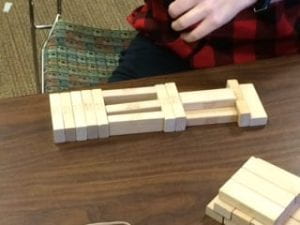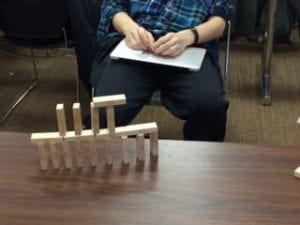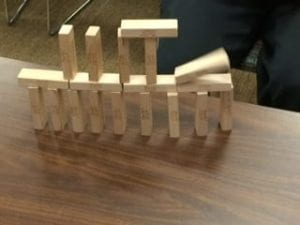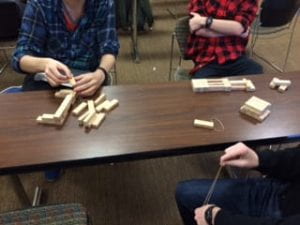Required Materials:
- At least one full Jenga set
- Two rubber bands per player
- People
Rules and Instructions: This game can be played by 2-3 players.
- Split the number of Jenga pieces evenly among all players.
- Each player will now construct a fortification out of Jenga pieces. The player will also set one piece aside as the “ammo piece.”[BUILD PHASE]
- The players will take turns attempting to destroy each other’s Jenga fortification with their “ammo piece.” The “ammo piece” will be fired at the defending fortification by using two rubber bands. (Use the rubber bands to create a slingshot with your index and middle fingers, then proceed to place the ammo piece in the rubber band slingshot and fire). [BATTLE PHASE]
- Any Jenga piece that falls off of the defender’s fortification during the Battle Phase is now considered the attacker’s war spoil and the attacker takes possession of those piece(s).[PLUNDER PHASE]
- If any player loses possession of all their pieces then that player is eliminated.
- Each player will continue to destroy each other’s forts and rebuilding their own after it is attacked. This cycle will continue unless if all the surviving players agree to make peace with one another and share all the pieces or until one player is left standing.
Note: Please do not use Jenga pieces to hit people .
Documentation:


The build phase

The battle phase

The plunder phase
Artist Statement
Throughout the Dada art movement there has been a consistent theme of anti-war sentiment that is represented through many of the artists’ work such as John Heartfield and Rudolf Schlichter’s “Prussian Archangel” and Kurt Schwitter’s “The Holy Affliction.” This theme served as my main inspiration of my game “Jenga Warz.” The game’s purpose is to simulate the never ending cycle of war and the destruction war brought.
Kurt Schwitter’s Merzbau piece “The Holy Infliction” represented his own feelings towards World War One. The piece is a chaotic combination of various objects attached to a human manikin which is reference to the many soldiers who had limbs amputated and got prosthetics limbs. Another striking feature of this piece is the German word for “insanity” written on a portion of the Merzbau sculpture. The violence, suffering, and carnage associated with the war did not make sense to Schwitter. I modeled this idea that war does not make sense into my game. I implemented a system in which the players battle over Jenga pieces (used to simulate resources or land) seemingly for no reason. A player may gain some Jenga pieces from attacking an enemy player, but they quickly lose it as another player will want those new pieces from themselves. The point was to show that the reasoning behind most, and probably all wars, are pointless as the gains are not eternal.
Many Dada artists were known for cutting out bits of newspapers and other texts to use in their art. Kurt Schwitter and Raoul Hausmann are examples of Dada artists who implemented this into their artwork. To me the cutting of newspapers symbolizes the destruction and fragmentation of the world they once knew. To me it represents the fragmentation of everything that once made sense to them in the world. The world was literally torn apart by the war. To model this idea of destruction in my game I literally implemented destruction. The instructions of my game stipulate that each player builds a fort out of Jenga pieces. Each fort takes time to build but an enemy is allowed to attack it and potentially destroy it. It is destroyed much like the world the Dadaist knew before the world was destroyed. My ultimate goal for this game and assignment was to reflect those ideas that I feel like the Dada artists were reacting to at the time.
